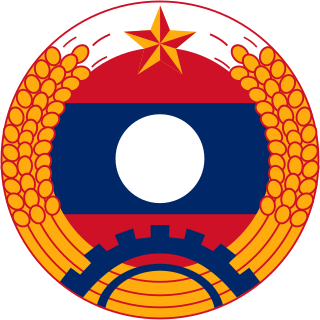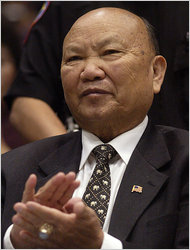
Laos, officially the Lao People's Democratic Republic, commonly referred to by its colloquial name of Muang Lao, is a socialist state and the only landlocked country in Southeast Asia. Located at the heart of the Indochinese peninsula, Laos is bordered by Myanmar (Burma) and China to the northwest, Vietnam to the east, Cambodia to the southwest, and Thailand to the west and southwest.

The Lao People's Armed Forces (LPAF) is the name of the armed forces of the Lao People's Democratic Republic and the institution of the Lao People's Revolutionary Party, who are charged with protecting the country.

The Kingdom of Laos was a constitutional monarchy that ruled Laos beginning with its independence on 9 November 1953. The monarchy survived until December 1975, when its last king, Savang Vatthana, surrendered the throne to the Pathet Lao, who abolished the monarchy in favor of a Marxist state called the Lao People's Democratic Republic, which has controlled Laos since.

Prince Phetsarath Ratanavongsa was the 1st Prime Minister of Laos from 8 April to 20 October 1945, and was the first and last vice-king of the Kingdom of Laos.
Major General Phoumi Nosavan was a military strongman who was prominent in the history of the Kingdom of Laos; at times, he dominated its political life to the point of being a virtual dictator. He was born in Savannakhet, the French Protectorate of Laos, on 27 January 1920. Originally a civil servant in the French colonial administration of Laos, during the last year of World War II he joined the resistance movement against the Japanese occupiers. Exiled from 1946 to early 1949 for his opposition to French return to colonizing Laos, he returned to his native soil to begin a military career in 1950 after the collapse of the anti-French Lao Issara government. By 1955, he was Chief of Staff of the brand-new Royal Lao Army. While in that position, he was largely responsible for appointing senior officers into command positions in the Military Regions of Laos. Following that, in 1957 he was the first Lao officer to be schooled in France at the École de Guerre. While in France, he became acquainted with Central Intelligence Agency operative John F. "Jack" Hasey. Phoumi returned to Laos to become a founding member of the Committee for the Defence of National Interests on 17 June 1958. On 25 December 1959, he took control of the capital of Vientiane and of the nation in a bloodless coup.
Prince Sauryavong Savang was the youngest son of King Savang Vatthana of Laos. In 1965, he married Princess Dalavan and they had four children, Sthira Sauryavong, Dayavant Sauryavong, Balavant Sauryavong, and Krishnajina Sauryavong.

Phoumi Vongvichit was a leading figure of the Pathet Lao and an elder statesman of the Lao People's Democratic Republic.

Vang Pao was a major general in the Royal Lao Army. He was a leader in the Hmong American community in the United States.
Crown Prince Soulivong Savang, grandson of the last King of Laos Savang Vatthana, is the pretender to the Lao throne. Laos was a monarchy until 1975, when the communist Pathet Lao seized control of the nation, causing Savang Vatthana to abdicate his throne. Soulivong Savang lives in exile in Paris.

Hmong Americans are Americans of Hmong or Miao descent from China, Southeast Asia, most notably from Thailand, Vietnam and Laos. Hmong Americans are one group of Asian Americans. Many Laotian Hmong war refugees resettled in the US following the North Vietnamese invasion of Laos and Laotian Civil War during the Vietnam War. Following the Vietnam People's Army invasion and take over of the Royal Kingdom of Laos, beginning in December 1975, the first Laotian Hmong refugees arrived in the US, mainly from refugee camps along the Mekong river in Thailand. Thousands of Laotian Hmong fled persecution, human rights violations, military attacks, ethnic cleansing, and religious freedom violations, at the hands of Marxist and communist forces, including those of the Lao People's Army. However, despite the tens of thousands of Hmong people persecuted and killed, only approximately 3,466 were reportedly granted asylum as official refugees at this time under the Refugee Assistance Act of 1975.
This article details the history of Laos since 1945.
The insurgency in Laos refers to the ongoing, albeit sporadic, military conflict of the Third Indochina War between the Lao People's Army, and Vietnam People's Army opposed primarily by members of the former "Secret Army" or the Hmong people as well as various other ethnic lowland Lao insurgencies in Laos, who have faced governmental reprisals due to Royal Lao and Hmong support for the American-led, anti-communist campaigns in Laos during the Laotian Civil War—which is an extension to the war itself. The North Vietnamese invaded Laos in 1958-59 and supported the communist Pathet Lao. It continued on the day after the end of the civil war with the Pathet Lao's capture of the Laotian capital Vientiane, who overthrew the Royal Kingdom of Laos and established a new government known as the Lao People's Democratic Republic.
Touby Lyfoung (1917–1979) was a Hmong political and military leader. Born in 1917 in Nong Het, Laos, he became the first Hmong politician to achieve national prominence. During his long career, which began under French colonial rule and extended to the communist takeover in 1975, he supported the Royal Lao Government and American involvement in the Secret War.
The alleged 2007 Laotian coup d'état plan was a conspiracy allegation by the United States Department of Justice that Lt. Col. Harrison Jack (Ret.) and former Royal Lao Army Major General Vang Pao, among others conspired in June 2007 to obtain large amounts of heavy weapons and ammunition in allegedly planning an attempt to overthrow the Communist government of Laos in violation of the Neutrality Act. The charges were ultimately dropped and the case helped serve to further highlight, instead, major human rights violations by the Lao government against minority Hmong and Laotian refugees and political and religious dissidents.

The Royal Lao Government in Exile (RLGE) is a Lao government in exile opposed to the Lao People's Democratic Republic. It purports to seek to institute a constitutional monarchy in Laos that ensures freedom, justice, peace, and prosperity for the Lao people.

Wangyee Vang is a Hmong-American community leader, educator and elder from Fresno, and the Central Valley, of California.
Major General Sourith Don Sasorith was a prominent Royal Lao Government commanding officer during the Laotian Civil War. Appointed to command the Royal Lao Air Force on two separate occasions, he was also entrusted two other times with command of a Military Region. At war's end in 1975, Sourith Don Sasorith was condemned to a communist re-education camp.









